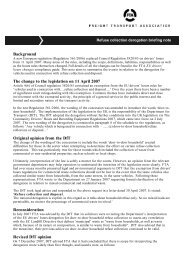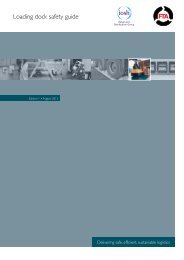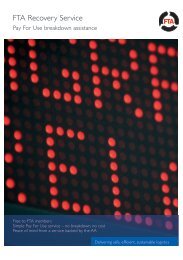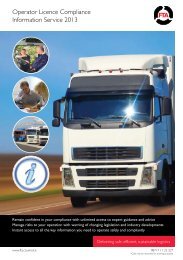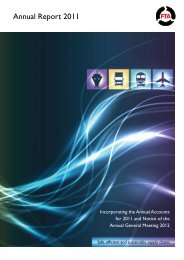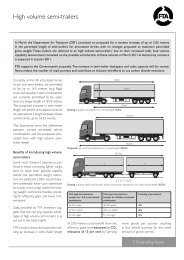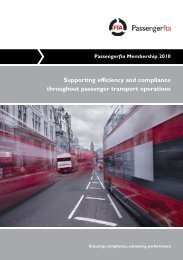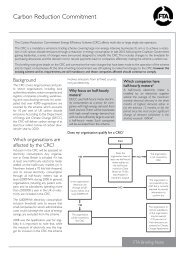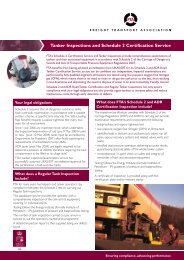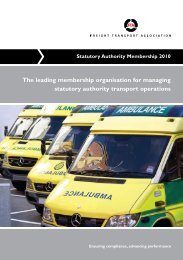loading/unloading code of practice - Freight Transport Association
loading/unloading code of practice - Freight Transport Association
loading/unloading code of practice - Freight Transport Association
- No tags were found...
Create successful ePaper yourself
Turn your PDF publications into a flip-book with our unique Google optimized e-Paper software.
section 1 IntroductionAims and objectivesThe aim <strong>of</strong> this <strong>code</strong> <strong>of</strong> <strong>practice</strong> is to bring togetherstakeholders to work collectively to improve thecompetitiveness <strong>of</strong> UK business.The objective <strong>of</strong> this <strong>code</strong> <strong>of</strong> <strong>practice</strong> is to promotebest <strong>practice</strong> amongst business, traffic authoritiesand parking enforcement contractors to findpositive and effective solutions where <strong>loading</strong>/un<strong>loading</strong> is an ongoing problem.BackgroundDelivery and servicing is vital to the UK’seconomy. With limited road space and competingdemands, ensuring appropriate <strong>loading</strong>/un<strong>loading</strong>arrangements are available is very challenging.The situation can be exacerbated when there isincorrect enforcement, when drivers ignore therules and when communication between trafficauthorities and delivery companies is inconsistent.In order to address this increasingly criticalconcern the major business and industry groups/organisations that represent the interests <strong>of</strong>thousands <strong>of</strong> businesses which either receive ormake deliveries <strong>of</strong> goods and services in Londoncame together in early 2005 to try and address theproblems with deliveries, <strong>loading</strong>/un<strong>loading</strong> and topromote best <strong>practice</strong>.On jointly re-examining the issue it becameapparent that there were a whole range <strong>of</strong>concerns that needed to be resolved – strategic,administrative, organisational and system related.At the same time there were pockets <strong>of</strong> progressand various initiatives underway to improve thedelivery and servicing situation on the ground.The chosen way forward was to undertake a coordinatedpartnership approach, involving all thekey stakeholders – businesses, traffic authorities,London Councils and parking enforcementcontractors.In 2008, part 6 <strong>of</strong> the Traffic Management Act 2004was implemented. This somewhat harmonisedthe previously differing rules in London and therest <strong>of</strong> England and Wales. Since then, more andmore local authorities outside London have beengranted Civil Parking Enforcement powers. As such,this document is no longer London-specific but hastaken on a national focus.There has been a conscious effort to involverepresentatives <strong>of</strong> each <strong>of</strong> the stakeholders indeveloping this <strong>code</strong> <strong>of</strong> <strong>practice</strong>. The aim is toestablish this as an authoritative document that willbe useful for all those involved, resulting in a muchimproved situation on the ground.This shared document sets out commonly agreedprinciples to improve communication and makethe system work as best as it can. It is in everyone’sinterest to save time and resources by reducing thenumber <strong>of</strong> Penalty Charge Notices (PCNs) issuedthat relate to deliveries that are undertaken incompliance with regulations and are subsequentlyoverturned on appeal with the supply <strong>of</strong> suitableevidence.How to use this documentThis document should be incorporated into trainingprogrammes and used as a reference guide for allthose involved in delivery and servicing, parkingenforcement and traffic management, to ensurethe widest possible dissemination <strong>of</strong> best <strong>practice</strong>.How is enforcement carried out?Traffic authorities can enforce parking and certaintraffic regulations either by using civil enforcement<strong>of</strong>ficers who patrol the streets who can issue PCNsor via CCTV cameras (see section 5). There aretwo other circumstances where a PCN may beserved by post. Either where the civil enforcement<strong>of</strong>ficer has been prevented from serving the PCNby obstruction or threats <strong>of</strong> violence or where thePCN has started to be issued but the vehicle hasbeen driven <strong>of</strong>f before it has been placed on thewindscreen.What is <strong>loading</strong>/un<strong>loading</strong>?The rules for <strong>loading</strong> and un<strong>loading</strong> differ fromthose for other parking activities. Traffic orders thatrestrict or prohibit waiting in a street may exemptthe <strong>loading</strong> or un<strong>loading</strong> <strong>of</strong> goods. Some authoritiesdesignate kerbspace just for <strong>loading</strong>.Loading or un<strong>loading</strong> must be continuous whilethe vehicle is parked in restricted areas. It includestaking goods to where the recipient may reasonablyrequire them in the premises, waiting for them to bechecked, getting delivery or collection documentssigned and returning to the vehicle. Delivery staffare expected to secure their vehicle when they are




